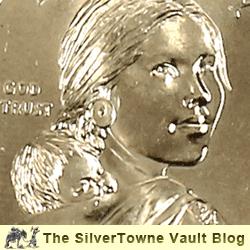
2012 Sacagawea Dollars
Since the year 2000, the famous Shoshone Indian woman Sacagawea has been featured on “Golden Dollars” produced by the United States Mint. Golden Dollar coins came about as a concentrated effort to remedy the lack of acceptance of the Susan B. Anthony Dollar coins, which many people confused with quarters due to their similarities (size, color and reeded edge). The United States Dollar Coin Act of 1997, which birthed the new Sacagawea Dollars, mandated that “The dollar coin shall be golden in color, have a distinctive edge, have tactile and visual features that make the denomination of the coin readily discernible...”. These requirements led to the smooth edge, a wider rim and of course the golden color of the Sacagawea and Native American Dollars.
A likeness of Sacagawea was chosen as the obverse for the coins from amongst many initial concepts. It was felt that this young Native American guide and interpreter displayed the spirit of liberty, peace and freedom when as a teenager she played a huge role in leading the famous Lewis and Clark expedition successfully across the continental United States. The design was created by Glenna Goodacre, a well-known sculptor. Goodacre used a Shoshone college student named Randy’L He-Dow Teton as a model for the likeness. Similar to how she would have been seen while on the Lewis and Clark expedition, Sacagawea is shown with her infant son, Jean Baptiste, strapped to her back. Inscriptions on the obverse of the coin include “LIBERTY” and “IN GOD WE TRUST”. The year and mint mark also appeared on the obverse from 2000-2008, but were moved to the edge of the coin in 2009 (see other changes below).
From 2000-2008, the reverse of the Sacagawea Dollar coin remained the same – showing an eagle in flight surrounded by 17 stars to represent the states in the Union at the time of the Lewis and Clark expedition. Since 2009 the reverse has changed annually, with designs created to memorialize Native Americans (both individuals and tribes) and their contributions to the development and history of the United States. The coins were thus officially renamed “Native American Dollars”, although they are still commonly referred to as Sacagawea Dollars.





The newest design, for 2012, is now available and features the design “Trade Routes in the 17th Century”. Previous designs include “Three Sisters” (2009), “Great Law of Peace” (2010), “Wampanoag Treaty” (2011). On the reverse of all years is inscribed “UNITED STATES OF AMERICA” and “ONE DOLLAR” (depicted on the newer Native American coins as “$1”). Also inscribed on the reverse from 2000-2008 was “E PLURIBUS UNUM”, but this inscription was moved to the edge of the coin from 2009 to present date (along with the year and mint mark, as mentioned above).
While they still haven’t been widely accepted as commonly circulating coinage, Golden Dollars (Sacagawea/Native American and from 2007 to present, Presidential Dollars as well) are popular with coin collectors. Start or continue your collection with the latest 2012 Sacagawea releases – available from SilverTowne as individual uncirculated coins, in rolls, or as part of mint and proof sets. As always, have fun building your collection!







